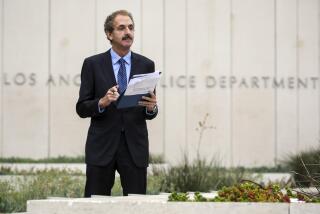Man of Many Aliases Named in Huge Fraud Case : Indictment: Capistrano Beach investor Douglas P. Blankenship is accused of masterminding a complex scheme that looted $25 million from financial institutions in seven states.
- Share via
SANTA ANA — If what federal prosecutors say about him is true, Douglas P. Blankenship would have brought the house down on “To Tell the Truth,” the old television show in which impostors tried to stump the panel.
Blankenship, a Capistrano Beach resident also known as John Perkins, Kenneth Stall, Randall Sanders and Kenneth Sliz, claims to be one of the nation’s largest real estate developers, a genius with a Ph.D. in transportation systems and a wealthy coal baron from the mountains of Kentucky.
Now a 300-page federal indictment is demanding that the real Blankenship stand up. Two weeks ago, he was arrested by the FBI and charged with using aliases, corporate fronts, phony tax returns and false financial statements to mastermind a $25-million fraud against financial institutions in seven states.
Blankenship, 45, is being held without bail in Metropolitan Detention Center in Los Angeles, awaiting a criminal trial on charges of racketeering, bank and mail fraud and fraudulent transportation. He faces a sentence of up to 65 years in jail if convicted.
Defense attorney Kenneth D. Miller said Blankenship is innocent.
“My feeling on this case is that the banks are taking big hits on (former Lincoln Savings & Loan owner Charles) Keating and my opinion is they are looking to point a finger at someone and that is Mr. Blankenship,” Miller said.
U.S. Magistrate Ronald W. Rose denied Blankenship bail earlier this month because he said there were too many unanswered questions about him, including “who he really works for . . . who pays his rent, what his real name is . . . where his assets are.”
Fourteen people in four states were indicted on lesser charges and 10 of them--including Blankenship’s girlfriend--have been apprehended by federal authorities, said Assistant U.S. Atty. Bob Westinghouse. In all, the group is charged with 33 counts of racketeering, fraud and other illegal acts.
The Blankenship case is not the largest alleged scam ever organized and operated in Orange County. Nor are the victims--large financial institutions--the kind that attract public sympathy, even though taxpayers could end up footing the bill for some of the fraud.
But what appears unusual is that the unknown son of an Appalachian coal miner could so easily persuade sophisticated institutions--which might reject a consumer loan because of a single credit blemish--to loan him millions of dollars.
It is that ability to persuade that has landed him in trouble. So good was his line that Orange County attorney Robert L. Green said in a civil lawsuit against Blankenship that he is “a con man rivaling J. David Dominelli and Ferdinand Marcos.” (Dominelli is a jailed San Diego financier and Marcos the late ruler of the Philippines.)
Blankenship honed his silver tongue in Kentucky, where he was raised with three siblings in a coal-miner’s family in the tiny town of Argo (population 175) just hours from the Daniel Boone National Forest and the hills where the infamous Hatfield-McCoy family feuds were fought.
Pike County Sheriff Charles (Fuzzy) Kessee has known Blankenship “since he was a boy” and was a buddy of his father, Herbert. The local tax commissioner and state senator were family friends too.
Phelps High School Principal Beth Compton said he was a “fine young man, in the top of his class.” Just about everyone in the Argo area thought Blankenship was bound for greatness and they weren’t surprised when he decided to move to California a few years after his graduation from Eastern Kentucky University.
But that quest has now led to the courthouse. Besides the criminal charges he faces, Blankenship has been named in more than 50 civil lawsuits in California and Kentucky, many of which alleged fraudulent activity.
Green hunted Blankenship for several years as an attorney representing Orange Coast Title Co. and Allstate Life Insurance, two companies that successfully claimed in civil actions that they had been victimized by him.
Earlier this month, after Blankenship landed in prison, Allstate got permission from an Orange County Superior Court Judge to foreclose on his Capistrano Beach home, clearing out his possessions including 20 handmade silk suits and a roomful of accolades including a certificate from Mensa, the society for individuals with high IQs.
Blankenship is described by prosecutors as a Gatsby-like raconteur who lived the high life even though his net worth was nearly nil. In one financial statement, he claimed he was a millionaire 99 times over.
When arrested he was driving a gold-colored Rolls-Royce. The luxury automobile has since disappeared, to the dismay of the U.S. attorney’s office. Miller, Blankenship’s attorney, said his client’s girlfriend owns the car.
“It’s not being concealed. It’s being garaged, “ Miller said.
Blankenship and his associates are accused of using paper corporations--including Pacific Coast National Development Corp. and Pacific Coast Plaza Inc.--to fraudulently obtain bank loans amounting to tens of millions of dollars.
A Blankenship company allegedly would apply for a substantial loan and offer as collateral the title on either his residence or a nearby office complex. Once the loan was made, the titles were transferred to another Blankenship company and another loan was sought from a different lender.
Once a bank or thrift tried to collect on a loan, the entity that was liable filed for bankruptcy, which prevented any kind of foreclosure on the property, according to federal prosecutors.
“He makes a cloud with so many confusing deals that lenders don’t understand it,” said Green. “They are transferring properties and leaving the lenders in the dust.”
For instance, Puget Sound National Bank in Tacoma, Wash., made a loan of $4.5 million to a Blankenship entity for the purchase of a San Clemente office building that Blankenship had said was worth $6.5 million, according to the indictment. The building’s actual value was $3 million, federal investigators claim.
The loan was made in June, 1986, and Blankenship pocketed $861,000 for himself, the indictment said. Then he did not repay the Tacoma bank. In order to stave off foreclosure, the defendants filed for bankruptcy. Puget National has recovered all but $1 million of the original loan.
All the while, Blankenship continued to collect between $30,000 and $35,000 a month in rents from the tenants of the San Clemente office complex including $1,380 a month from Rep. Ron Packard (R-Carlsbad), whose local headquarters are based there, according to documents in civil cases.
Those who claim they were defrauded say Blankenship had a good answer to every question and could recite relevant statistics from memory, a performance so convincing they decided to forgo normal background checks.
“Mr. Blankenship is a crook,” Orange County Superior Court Judge Robert L. Polis concluded in a 1988 civil case by a creditor claiming one of the title transfers was fraudulent.
Not everyone was fooled by Blankenship’s act. A former Grubb & Ellis real estate agent said that when she met him last year her “woman’s intuition” told her there was something strange about her new client--a man going by the name of John Perkins. He had called to say he needed an agent because he wanted to buy and sell commercial office buildings around Orange County.
“He was very knowledgeable. He knew lots of little things about property in Orange County--ownerships and vacancies,” recalled the agent, who asked not to be named. “But I just started getting instincts that things were going wrong. I voiced my concerns and we would go to a meeting and he would explain it away.”
And then she noticed the monogram on Perkins’ white dress shirt--DPB--didn’t match his initials.
“I was just real blunt and I said, ‘Who are you?’ By then we were nervous and didn’t know quite what was going on,” the agent recounted. “He gulped and said, ‘My real name is Douglas P. Blankenship and the reason I use this other name is because I have so much money that when people find out I want to buy a property the price goes up.’ ”
Blankenship furnished Grubb & Ellis with articles from National Real Estate Investor and other trade publications listing him as one of the largest owners of apartment buildings in the country. Federal investigators won’t comment on those articles but civil attorneys including Green claim they were planted in those journals and are filled with falsehoods.
Miller said he hadn’t seen the articles and could not comment on them. But in his client’s defense, he said: “Everyone has made him out to be a heel. He’s just not that way.” Blankenship has said in sworn depositions he has built $468 million worth of real estate projects including 12 commercial strip centers, nine office buildings, nearly 3,000 condominiums and a mall. This would put Blankenship and his companies on a par with some of the largest developers in the United States.
Financial statements, allegedly audited by certified public accountants, such as those submitted to Grubb & Ellis, indicated he had a net worth of as much as $99 million. Just a year later he filed for bankruptcy and claimed total assets of $7,600.
“He showed almost no net worth,” said James Joseph, a court-appointed trustee assigned to oversee Blankenship’s assets.
Federal prosecutors claim the audited financial statements were phony and four of the 15 people indicted were the accountants who prepared them at Blankenship’s direction.
Grubb & Ellis finally severed all ties with Blankenship after two buildings he listed for sale with them--his residence and office--were discovered to be the subject of liens in several lawsuits.
“He had so many stories,” said the Grubb & Ellis agent. “They were incredible.”
So are the backgrounds of some of those accused of helping him, contained either in the criminal indictment or in the numerous civil lawsuits filed against Blankenship and his firms.
Michael E. Hilander, who was indicted with Blankenship on racketeering, perjury and wire and mail fraud charges, has a criminal record in California for grand theft. At the time of his indictment he was carrying three driver’s licenses with three different names. He has denied the charges against him through his attorney.
Larry Frankhouser, who is described in the indictment as Blankenship’s chief of staff, was getting into trouble with his longtime friend as far back as the mid-1980s.
For instance, Michelle Moffett and her husband were in dispute with Blankenship and Frankhouser three years ago regarding the rightful ownership of a Beverly Hills home once occupied by Blankenship. The property was the subject of several liens because of civil litigation against Blankenship.
The men “appeared on the premises in an attempt to take physical possession of the premises, “ Moffett said in a deposition. “Larry Frankhouser was brandishing a handgun, waving it at us in a threatening manner stating, ‘There’s going to be a shoot-out in a few minutes.’ ”
Perhaps Blankenship’s most interesting colleague is Phil Livingstone, a self-described former counterintelligence agent living in a Costa Mesa mobile home who claims he also was once a professional golfer. He further claimed to be chief executive officer of the Chapel of the Living Waters and another entity called Shelter of the Lambs.
Livingstone was not named in the criminal indictment and isn’t accused of any wrongdoing, but what he has said in civil cases provides further insight into the way Blankenship allegedly did business.
The 51-year-old Livingstone has testified to receiving $500 a month for serving as president of one or more of Blankenship’s companies, but those who have come into contact with him say he was simply a figurehead.
“He didn’t know beans,” said Darrell J. McKibban, a real estate broker with Lee & Associates. “It was some guy they just pulled off the street.”
Livingstone has testified he can’t remember how he gets paid or by whom, and even simple questions like the name of the street on which the Chapel of the Living Waters is located causes him to draw blanks.
Despite the background of some of his associates and his own legal problems, Blankenship still has many supporters.
News of Blankenship’s indictment and incarceration has reached his rural hometown, surprising residents there.
“After we got your message, I talked with my husband and said, ‘What do you suppose the Los Angeles Times is writing?’ ” recalled Compton, his former high school principal. “He said, ‘He has probably achieved something big and they are probably writing about it.’ ”
More to Read
Sign up for Essential California
The most important California stories and recommendations in your inbox every morning.
You may occasionally receive promotional content from the Los Angeles Times.













